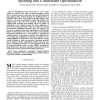Free Online Productivity Tools
i2Speak
i2Symbol
i2OCR
iTex2Img
iWeb2Print
iWeb2Shot
i2Type
iPdf2Split
iPdf2Merge
i2Bopomofo
i2Arabic
i2Style
i2Image
i2PDF
iLatex2Rtf
Sci2ools
126
Voted
TIP
2010
2010
Multiplicative Noise Removal Using Variable Splitting and Constrained Optimization
Multiplicative noise (also known as speckle noise) models are central to the study of coherent imaging systems, such as synthetic aperture radar and sonar, and ultrasound and laser imaging. These models introduce two additional layers of difficulties with respect to the standard Gaussian additive noise scenario: 1) the noise is multiplied by (rather than added to) the original image; 2) the noise is not Gaussian, with Rayleigh and Gamma being commonly used densities. These two features of multiplicative noise models preclude the direct application of most state-of-the-art algorithms, which are designed for solving unconstrained optimization problems where the objective has two terms: a quadratic data term (log-likelihood), reflecting the additive and Gaussian nature of the noise, plus a convex (possibly nonsmooth) regularizer (e.g., a total variation or wavelet-based regularizer/prior). In this paper, we address these difficulties by: 1) converting the multiplicative model into an addi...
| Added | 22 May 2011 |
| Updated | 22 May 2011 |
| Type | Journal |
| Year | 2010 |
| Where | TIP |
| Authors | José M. Bioucas-Dias, Mário A. T. Figueiredo |
Comments (0)

